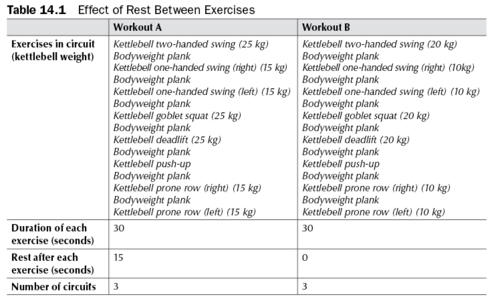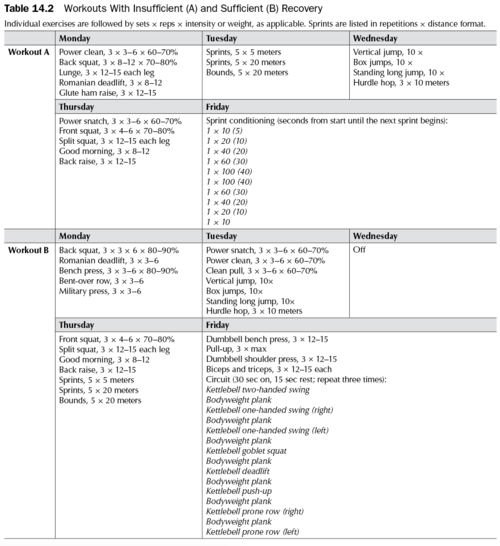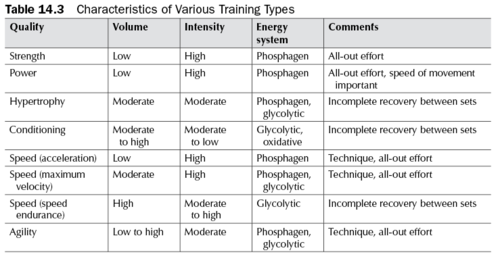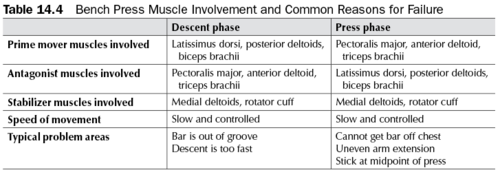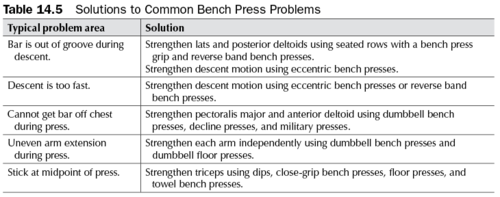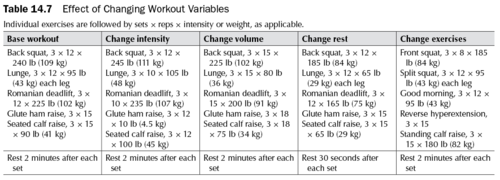Program Variables
Several key training variables must be addressed, manipulated, and successfully integrated to create an effective, comprehensive training program. The interplay of these variables can have a profound impact on the results you get. The variables must be balanced according to your needs, whether the primary goal is reducing fat, improving health and fitness, or enhancing sport performance. These concepts must be fully understood to optimize training results.
Five major variables must be considered when designing a training program:
- Intensity
- Volume
- Rest
- Recovery
- Muscle balance
Intensity
Intensity refers to the quality and difficulty of the exercise. An inverse relationship exists between the intensity of an exercise and its volume (sets × repetitions). Intense exercise sessions are stressful and can be extremely fatiguing, so you must reduce the volume of training because fatigue will limit the number of quality repetitions that you will be able to perform. You will also need more rest and recovery after intense training sessions when compared with less intense sessions.
In a traditional strength-training workout, intensity is prescribed according to a percentage of the maximum weight (a percentage of one-repetition maximum, or 1RM) or maximum number of repetitions that you can lift at a certain weight (called a repetition maximum, or RM). For example, if you can squat 300 pounds (136 kg), then training at 70 percent of the 1RM would mean working out with 210 pounds (95 kg). On the other hand, if you wanted to train at your 10RM, you would work with a weight that you could lift a maximum of 10 times.
People are typically instructed to perform plyometric, speed, and agility drills at maximal intensity. In other words, with these types of training, athletes train at or close to their maximum speed and power. The intent of these exercises is to teach athletes how to be more explosive, so training at less than maximal intensity doesn’t develop this ability.
With maximum interval training, intensity is calibrated a little differently. Here the focus is on helping you become resistant to the effects of fatigue. This type of training is not the most effective training approach to increase strength, power, or maximal speed. The selected intensity should allow you to complete the desired volume of exercise with good form and technique.
Volume
The volume is the quantity of the work that is being done. With strength training it is usually the number of repetitions multiplied by the number of sets. For example, performing three sets of 10 repetitions produces a volume of 30. But when performing maximum interval training, volume can be expressed in a number of ways. It can also be expressed in terms of time, distance, number of jumps, number of throws, and so on. For example, when performing kettlebell swings for 30 seconds, volume can be quantified by time. Volume can also be expressed in terms of distance, such as sprinting for 40 meters. Or it can reflect the number of repetitions, such as performing 20 crunches.
The greater the volume is, the lower the training intensity should be. Besides having an inverse relationship with intensity, volume is a powerful stimulus for various types of adaptations from training. For example, low volume is appropriate for activities that require a great deal of technique, speed, and power. Moderate volumes are good for developing hypertrophy. Higher volumes help enhance resistance to fatigue.
Rest
Rest refers to the time taken after each set of an exercise. Longer rest periods allow you to achieve greater training intensity. For example, if you train with heavy weights, you should allow at least three to five minutes of rest after each set to recover. You could then lift a greater amount of weight each set. Rest can also be important for the transferability of training. For instance, if you play a sport that typically has 10 to 20 seconds of rest after each play, you can design your training program to mimic those work and rest periods.
With maximum interval-training workouts, rest periods have a large effect on the difficulty of the training. Consider the sample workouts in table 14.1. Both workouts involve the same exercises, the same number of times through the circuit, and the same volume of training. The difference is that the athlete rests for 15 seconds after each exercise in workout A but does not rest after each exercise in workout B. As a result, the athlete can handle more weight on the kettlebells and will feel less fatigued when performing workout A than when performing workout B. Note: The italicized exercises are in part II. Refer to the exercise finder for more information.
Click here to go the exercise finder, which will link you to each exercise found in part II.
Recovery
Recovery refers to the time between exercise sessions. This period is important because it is when all the adaptations that we are training for occur. Failure to allow adequate recovery can eventually lead to a state of overtraining and injury. Although training every day is possible, special care must be taken to ensure that the activities are organized so that the same muscles, physical abilities, and qualities are not trained on successive days.
Table 14.2 shows two sample weeks of workouts. In the figure, workout A involves lower-body strength training and the power clean on Monday, sprints on Tuesday, plyometrics on Wednesday, lower-body strength training and the power snatch on Thursday, and sprint-based conditioning on Friday. On the surface this plan looks like an appropriate distribution of the workload across the week. The reality is that workout A involves a great deal of lower-body work Monday through Friday, so the schedule does not optimize recovery.
Workout B in table 14.2 takes a different approach. Monday involves total-body strength training with very heavy weights. Tuesday is focused on power training. Wednesday is a day off. Thursday involves lower-body strength training combined with sprints. Friday uses upper-body strength training, kettlebells, and core exercises for conditioning. In workout B the training sessions are distributed to allow the body a chance to recover.
Click here to go the exercise finder, which will link you to each exercise found in part II.
Training needs to be organized so that the muscles and energy systems get a chance to recover. In general, the 48-hour rule (i.e., rest a muscle group 48 hours before training it again) is a good one to follow. To help conceptualize the concept of recovery, table 14.3 describes the relationship between energy systems, qualities, and training. The table shows that certain types of training essentially train the same energy systems and require the same qualities. For example, strength, power, acceleration, maximum velocity, and even agility training all link up well and are considered compatible. On the other hand, hypertrophy training, speed endurance, and conditioning all link up. Using this example, strength and acceleration work would complement each other if they were done on the same day, but strength and speed endurance would not. This table provides some guidance on how to organize training so that the body has a chance to recover.
Muscle Balance
Several important concepts are related to muscle balance. First, you should train all the muscles around a joint, whatever the type or purpose of your training. Failing to do this creates strength imbalances around the joint that can set you up for injury in the long term. For example, if you perform a pushing exercise like a chest press on a suspension trainer, you should balance that out with a pulling exercise like the suspension trainer row. Similarly, a number of total-body, kettlebell, heavy ropes, sprinting, and medicine ball exercises should be incorporated over time into a program to help ensure that you achieve muscle balance.
Second, you should perform an equivalent amount of work on opposite movements. For example, if you perform three sets of pushing movements, you should perform three sets of pulling movements. This approach prevents one side of the body from being overdeveloped.
Third, these concepts apply to nontraditional examples as well. They are not limited to weight room exercises. For example, if you are pushing a weighted sled as part of your workout, you would also want to spend some time walking backward and pulling it.
